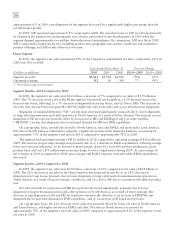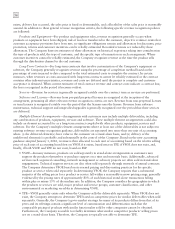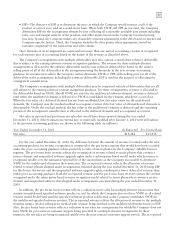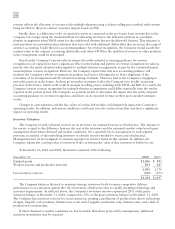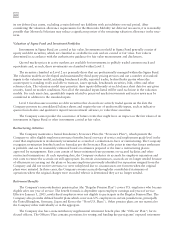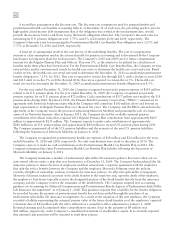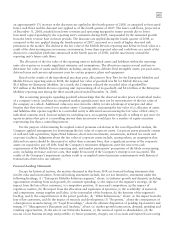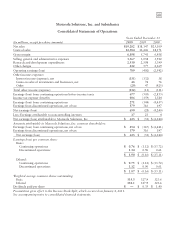Motorola 2010 Annual Report Download - page 72
Download and view the complete annual report
Please find page 72 of the 2010 Motorola annual report below. You can navigate through the pages in the report by either clicking on the pages listed below, or by using the keyword search tool below to find specific information within the annual report.
64
The determination of fair value of the reporting units and assets and liabilities within the reporting units
requires the Company to make significant estimates and assumptions. These estimates and assumptions primarily
include, but are not limited to, the discount rate, terminal growth rates, earnings before depreciation and
amortization, and capital expenditures forecasts. Due to the inherent uncertainty involved in making these
estimates, actual results could differ from those estimates.
The Company evaluated the merits of each significant assumption, both individually and in the aggregate, used
to determine the fair value of the reporting unit, as well as the fair values of the corresponding assets and liabilities
within the reporting unit, and concluded they are reasonable. The Company has weighted the valuation of its
reporting units at 75% based on the income approach and 25% based on the market-based approach, consistent
with prior periods. Motorola Mobility believes that this weighting is appropriate since it is often difficult to find
other appropriate companies that are similar to our reporting units and it is our view that future discounted cash
flows are more reflective of the value of the reporting units.
For the annual goodwill impairment test performed in the fourth quarter of 2010, The Government and Public
Safety, Enterprise Mobility, Mobile Devices, and Broadband Home reporting units had fair values that substantially
exceeded its carrying values. For the Access Networks reporting unit, the Company calculated a fair value that was
within 11% of the carrying value, using a discount rate of 14% and a terminal growth rate of 3%. The Company
believes these assumptions to be reasonable based upon the risk profile and long-term growth prospects of this
reporting unit in light of industry market data. In assessing the reasonableness of the calculated fair value of the
Access Networks reporting unit, the Company determined that the discount rate used to determine fair value would
need to be increased by over 2% for the Access Networks reporting unit before its calculated fair value would be
less than its book value. The Company does not believe the resulting discount rate would be reasonable relative to
the risks associated with the future cash flows of this business. The Company also determined that the terminal
growth rate used to determine fair value would need to decline from 3% to below 1% before its calculated fair
value would be less than its book value. This growth rate would not be reasonable given the expected growth of the
Access Networks reporting unit’s business nor the industry expectations of the growth in the reporting unit’s
markets. Finally, a heavier weighting on the market-based approach would increase the calculated fair value of the
reporting unit. Therefore, the Company believes the inputs and assumptions used in determining the fair value of
the Access Networks reporting unit are reasonable.
Based on the results of our 2009 and 2010 annual assessments of the recoverability of goodwill, the fair values
of all reporting units exceeded their book values, indicating that there was no impairment of goodwill.
Differences in the Company’s actual future cash flows, operating results, growth rates, capital expenditures,
cost of capital and discount rates as compared to the estimates utilized for the purpose of calculating the fair value
of each reporting unit, as well as a decline in the Company’s stock price and related market capitalization, could
affect the results of our annual goodwill assessment and, accordingly, potentially lead to future goodwill impairment
charges.
Following is a discussion of the goodwill impairment charges recorded for the year ended December 31, 2008.
During the fourth quarter of 2008, the Company experienced a sustained, significant decline in its stock price
that reduced the market capitalization below the book value of the Company. The reduced market capitalization
reflected the macroeconomic declines coupled with the market view on the performance of the Mobile Devices
reporting unit. The Company considered this decline in its stock price in the impairment assessment.
Based on the results of Step One of our 2008 assessment of the recoverability goodwill, the fair values of the
Home, Networks and Government and Public Safety reporting units exceeded their carrying values, indicating that
there was no impairment of goodwill at these reporting units.
However, the fair values of the Enterprise Mobility and Mobile Devices reporting units were below their
respective book values, indicating a potential impairment of goodwill and the requirement to perform Step Two of
the analysis for these reporting units. The Company acquired the main components of the Enterprise Mobility
reporting unit in 2007 at which time the book value and fair value of the reporting unit were the same. Because of
this fact, the Enterprise Mobility reporting unit was most likely to experience a decline in its fair value below its
book value as a result of lower values in the overall market and the deteriorating macroeconomic environment and
the market’s view of its near-term impact on the reporting unit. The decline in the fair value of the reporting unit, as
measured in the fourth quarter of 2008, resulted from lower forecasted future cash flows for the reporting unit and


